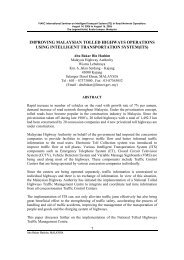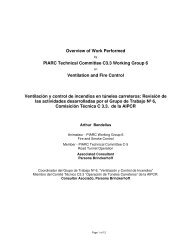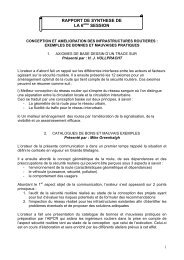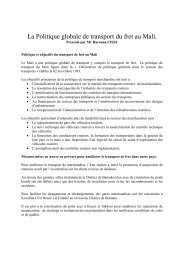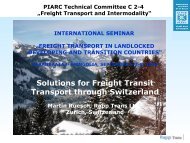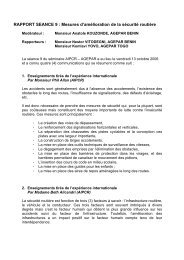Agricultural Roads in Bhutan AU
Agricultural Roads in Bhutan AU
Agricultural Roads in Bhutan AU
You also want an ePaper? Increase the reach of your titles
YUMPU automatically turns print PDFs into web optimized ePapers that Google loves.
<strong>Agricultural</strong> <strong>Roads</strong> <strong>in</strong> <strong>Bhutan</strong><br />
Ugyen Chewang<br />
<strong>in</strong>frastructure comb<strong>in</strong>ed with multi-sectoral plans for modernization of agriculture. These<br />
<strong>in</strong>terventions are aimed to enhance agricultural productivity as well as to improve access to<br />
markets. The observation that villagers nearer to the road are more prosperous <strong>in</strong> terms of<br />
economic and social well be<strong>in</strong>g than those further away is a clear <strong>in</strong>dication that poverty<br />
reduction, <strong>in</strong>creas<strong>in</strong>g opportunities and enhanc<strong>in</strong>g the quality of social services can be<br />
achieved by improv<strong>in</strong>g the rural access through <strong>in</strong>frastructure expansion.<br />
The <strong>Bhutan</strong>ese approach to development has been shaped and guided by the concept of<br />
Gross National Happ<strong>in</strong>ess (GNH) enunciated by His Majesty K<strong>in</strong>g Jigme S<strong>in</strong>gye Wangchuk<br />
<strong>in</strong> the late 1980s, which <strong>in</strong>dicates that development has many more dimensions and that<br />
development should be understood as a process that seeks to maximize happ<strong>in</strong>ess rather<br />
than economic growth.<br />
The Royal Government of <strong>Bhutan</strong> (RGoB) has addressed a wide range of poverty issues<br />
broadly through the expansion of social services, rural development and <strong>in</strong>come generation<br />
activities, where<strong>in</strong> a vast majority of our population has benefited <strong>in</strong> very tangible ways.<br />
3. Vision 2020<br />
In the Vision 2020 document, provisions have been <strong>in</strong>cluded that stress the importance of<br />
improv<strong>in</strong>g rural access through <strong>in</strong>frastructure expansion of roads.<br />
Local communities irrespective of their location with<strong>in</strong> the K<strong>in</strong>gdom stress the importance of<br />
roads and electricity. They serve to br<strong>in</strong>g the communities out of their isolation, they <strong>in</strong>crease<br />
access to markets and services, and they facilitate rural <strong>in</strong>dustrialization and hence create<br />
productive employment outside the RNR (Renewal Natural Resources) sector. Both roads<br />
and electricity are <strong>in</strong>strumental <strong>in</strong> improv<strong>in</strong>g both the standard of liv<strong>in</strong>g and quality of life <strong>in</strong><br />
the rural areas and are thus able to contribute to a reduction <strong>in</strong> rates of rural-urban<br />
migration.<br />
Farm<strong>in</strong>g and related activities must become more profitable and young people must perceive<br />
farm<strong>in</strong>g not as a subsistence activity they associate with ‘backwardness’ but as a field of<br />
opportunity. The cont<strong>in</strong>uation of the focus on rural development and the further<br />
commercialization of agriculture are essential components <strong>in</strong> our urbanization strategy.<br />
4. Farm Road: def<strong>in</strong>ition and mandate<br />
There are five categories of roads <strong>in</strong> <strong>Bhutan</strong>: highways, Dzongkhag roads, feeder roads,<br />
urban roads, and farm roads. A farm road is a road that l<strong>in</strong>ks agricultural production areas to<br />
the national highways and/or markets. Class D road type of the Road Design Manual<br />
(PWD/DoR), which is the lowest classification of motorable roads, is used as the geometric<br />
design standard of farm roads. Once a farm road is constructed and handed over to a<br />
community, the responsibility of repair and ma<strong>in</strong>tenance is placed on the community.<br />
The Royal Government has placed high priority to the construction of farm roads with the<br />
objective of l<strong>in</strong>k<strong>in</strong>g the potential agricultural surplus areas <strong>in</strong> the h<strong>in</strong>terland to markets or<br />
nearby highways to facilitate the movement of <strong>in</strong>puts, agricultural surplus products, farm<br />
mach<strong>in</strong>ery, etcetera. The aim of the Government is to improve the rural economy and<br />
ultimately to raise the overall liv<strong>in</strong>g standard <strong>in</strong> the rural villages and to make the rural areas<br />
more attractive <strong>in</strong> order to prevent rural-urban migration of these people.<br />
The exist<strong>in</strong>g Government policy mandates the Division of <strong>Roads</strong> (DoR) to construct roads.<br />
Under DoR, the pace of farm road construction has not picked up to the desired pace. This<br />
has also slowed down the pace of progress of RNR programs. Further, the farm roads have<br />
PIARC – RGC, Siem Reap, November 2005 Paper 9 Page 2



